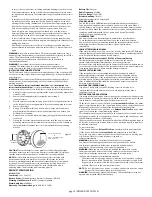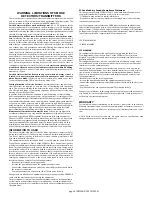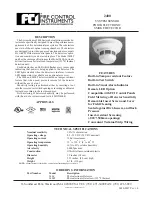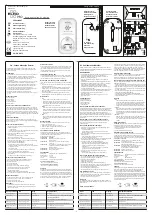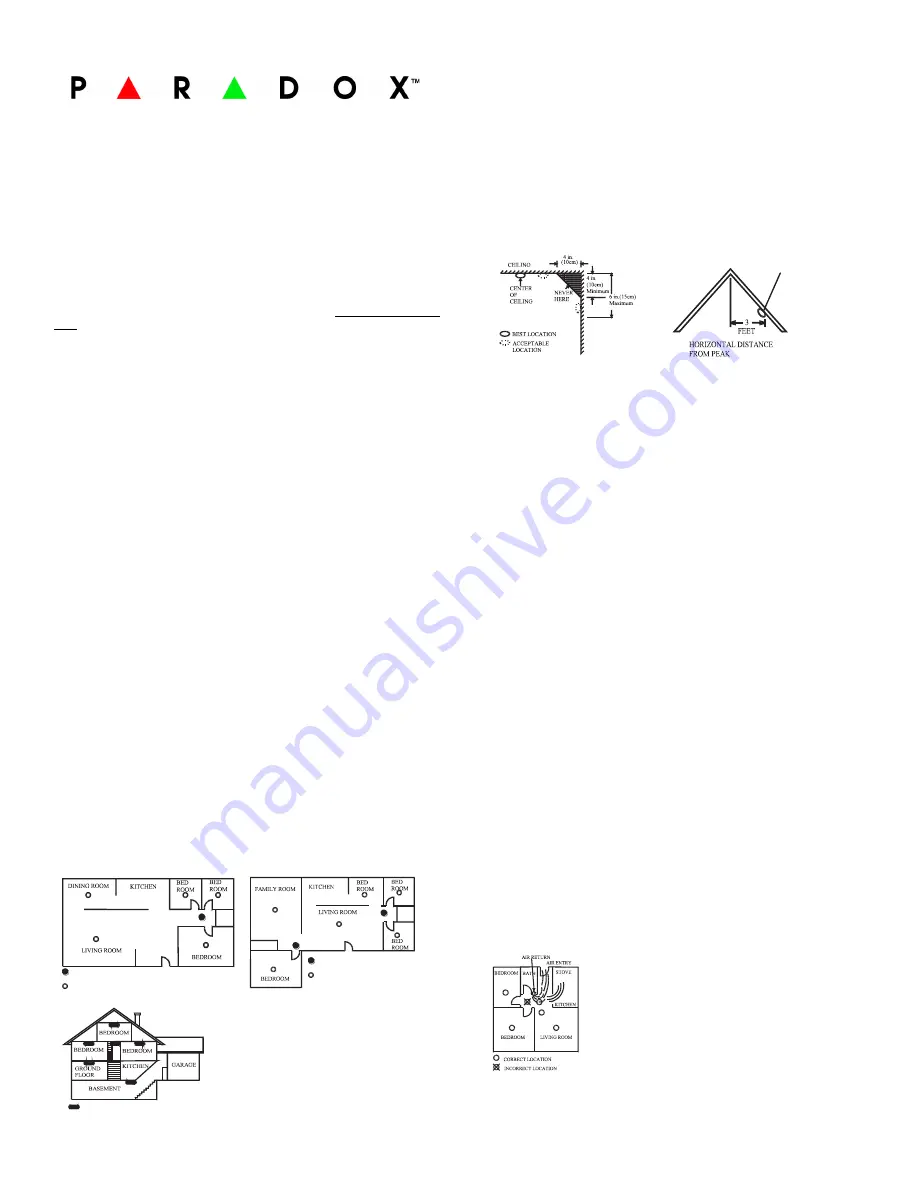
page 1(SD360-EI02 10/2014)
LONG BATTERY LIFE SINGLE STATION
BATTERY POWERED
PHOTOELETRIC SMOKE DETECTOR
SD360 USER’S MANUAL
INTRODUCTION
PARADOX single station photoelectric smoke detector SD360 is designed to sense
smoke that comes into the alarm chamber. It does not sense gas, or flame. This
smoke detector is designed to give early warning of developing fires by giving off
the alarm sounds from its built-in alarm horn. It can provide precious time for you
and your family to escape before a fire spreads. However, the smoke detector
makes such pre-warning of fire accident possible, only if the smoke detector is
located, installed, and maintained properly as described in this User's Manual.
WARNING
: This smoke detector is designed for use in a single residential unit
only, which means that it should be used inside a single family home or apart-
ment. It is not meant to be used in lobbies, hallways, basements, or another apart-
ment in multi-family buildings, unless there are already working alarms in each
family unit. Smoke detectors, placed in common areas outside of the individual
living unit, such as on porches or in hallways, may not provide early warning to
residents. In multi-family buildings, each family living unit should set up its own
detectors.
WARNING:
This detector is not meant to be used in non-residential buildings.
Warehouses, industrial or commercial buildings, and special purpose non-resi-
dential buildings require special fire detection and alarm systems. This detector
alone is not a suitable substitute for complete fire detection systems for places
where many people live or work, such as hotels or motels. The same is true of dor-
mitories, hospitals, nursing homes or group homes of any kind, even if they were
once single family homes. Please refer NFPA 101, the Life Safety Code, 72A for
smoke detector requirements for fire protection in buildings not defined as
“households”.
WARNING:
This detector will not alert people who are hard of hearing. It is
strongly recommended that the special-purpose smoke detectors using lights or
vibrating devices, should be installed to alert occupants who are hard of hearing.
LOCATIONS TO INSTALL YOUR SMOKE DETECTOR
Smoke detectors should be installed in accordance with the NFPA Standard 74
(National Fire Protection Association, Battery march Park, Quincy, MA 02169). For
complete coverage in residential units, smoke detectors should be installed in all
rooms, halls, storage areas, basements, and attics in each family living unit. Mini-
mum coverage is one detector on each floor and one in each sleeping area. Here
,
we have useful tips for you:
•
Install a smoke detector in the hallway outside every separate bedroom area,
as shown in Figure 1. Two detectors are required in homes with two bedroom
areas, as shown in Figure 2.
•
Install a smoke detector on every floor of a multi-floor home or apartment, as
shown in Figure 3.
•
Install a minimum of two detectors in any household.
•
Install a smoke detector inside every bedroom.
•
Install smoke detectors at both ends of a bedroom hallway if the hallway is
more than 40 feet (12 meters) long.
•
Install a smoke detector inside every room where one sleeps with the door
partly or completely closed, since smoke could be blocked by the closed door
and a hallway alarm may not wake up the sleeper if the door is closed.
•
Install basement detectors at the bottom of the basement stairwell.
•
Install second-floor detectors at the top of the first-to-second floor stairwell.
Be sure no door or other obstruction blocks the path of smoke to the detector
.
•
Install additional detectors in your living room, dining room, family room, attic,
utility and storage rooms.
•
Install smoke detectors as close to the center of the ceiling as possible. If this is
not practical, put the alarm on the ceiling, no closer than 4 inches (10 cm) from
any wall or corner, as shown in Figure 4.
•
If ceiling mounting is not possible and wall mounting is permitted by your
local and state codes, put wall-mounted detectors between 4 and 6 inches (10
~ 15 cm) from the ceiling, also see Figure 4.
•
If some of your rooms have sloped, peaked, or gabled ceilings, try to mount
detectors 3 feet (0.9 meter) measured horizontally from the highest point of
the ceiling as shown in Figure 5.
CAUTION
(As required by the California State Fire Marshall)
“Early warning fire” detection is best achieved by the installation of fire
detection equipment in all rooms and areas of the household as follows: (1)
A smoke detector installed in each separate sleeping area (in the vicinity, but
outside of the bedrooms), and (2) smoke detectors in the living
rooms, dining rooms, bedrooms, kitchens, hallways, attics, furnace rooms,
closets, utility and, storage rooms, basements and attached garages.”
For your information, NFPA Standard 72, Section 29 reads as follows:
“29.5.1 Smoke detectors shall be installed outside of each separate sleeping
area in the immediate vicinity of the bedrooms and on each additional
story of the family living unit including basements and excluding crawl
spaces and unfinished attics.
The provisions of 29.5.1 represent the minimum number of detectors
required by this standard. It is recommended that the householder
consider the use of additional smoke detectors for increased protection for
those areas separated by a door from the areas protected by the required
smoke detectors under 29.5.1 above. The recommended additional areas
are living room, dining room, bedroom(s), kitchen, attic (finished or
unfinished), furnace rooms, utility room, basement, integral or attached
garage, and hallways not included in 29.5.1 above. However, the use of
additional detectors remains the option of the householder.” We recommend
complete coverage and use of additional smoke detectors.
LOCATIONS NOT TO INSTALL YOUR SMOKE DETECTORS
Nuisance alarms take place when smoke detectors are installed where they
will not work properly. To avoid nuisance alarms, do not install smoke
detectors in the following situations:
•
Combustion particles are the by-products of something that is burning. Thus
in or near areas where combustion particles are present you do not install the
smoke detector to avoid nuisance alarms, such as kitchens with few windows
or poor ventilation, garages where there may be vehicle exhaust, near fur-
naces, hot water heaters, and space heaters.
•
Do not install smoke detectors less than 20 feet (6 meters) away from places
where combustion particles are normally present, like kitchens. If a 20-foot dis-
tance is not possible, e.g. in a mobile home, try to install the detector as far
away from the combustion particles as possible, preferably on the wall. To pre-
vent nuisance alarm alarms, provide good ventilation in such places.
IMPORTANT
: For any reason, do not disable the
detector to avoid nuisance alarms.
•
When air streams passing by kitchens, the way how a detector can sense com-
bustion particles in normal air-flow paths is graphically shown in Figure 6,
which indicates the correct and incorrect smoke detector locations concerning
this problem.
•
In damp or very humid areas, or near bathrooms with showers. Moisture in
humid air can enter the sensing chamber, then turns into droplets upon cool-
ing, which can cause nuisance alarms. Install smoke detector at least 10 feet (3
meters) away from bathrooms.
Figure 1:
LOCATIONS FOR PLACING SMOKE DETECTORS
FOR SINGLE RESIDENCE WITH ONLY ONE
SLEEPING AREA
Figure 2:
LOCATIONS FOR PLACING SMOKE DETECTORS
FOR SINGLE-FLOOR RESIDENCE WITH MORE
THAN ONE SLEEPING AREA
Figure 3:
LOCATION FOR PLACING SMOKE
DETECTORS FOR A MULTI-FLOOR
RESIDENCE
Smoke detectors for minimum security
Smoke detectors for more security
Smoke detectors for minimum security
Smoke detectors for more security
Smoke detectors for minimum security
Figure 4:
RECOMMENDED BEST AND ACCEPT-
ABLE LOCATIONS TO MOUNT SMOKE
DETECTORS
Figure 5:
RECOMMENDED LOCATION TO MOUNT SMOKE
DETECTORS IN ROOMS WITH SLOPED, GABLED,
OR PEAKED CEILING
Smoke Detector
Figure 6:
RECOMMENDED SMOKE
DETECTORS LOCATIONS TO
AVOID AIR STREAMS WITH
COMBUSTION PARTICLES


